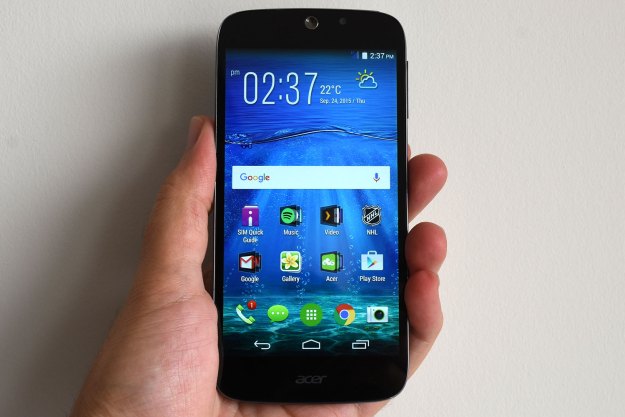
“Acer’s Liquid Jade Z oscillates between being wieldy and cheap.”
- Nice display with good contrast
- Thin and light
- Wider aperture for camera
- Dual nano SIM and microSD slot
- Feels cheap
- Camera performance is a mixed bag
- Runs on Android 4.4 KitKat
- Battery life
Acer’s entry into the smartphone market has been deliberately slow, especially in North America, where competition is tight and it’s easy for makers to get lost in the crowd. Much like its PC business, the high-end flagship isn’t Acer’s game. It’s the sandbox of the mid-range and lower that the company wants to play in, as it looks to gain a sliver of market share.
It’s considerably lighter and thinner than other handsets with 5-inch displays.
The Liquid Jade Z has already been on the market in Asia and Europe for months, though its availability in the U.S. as an affordable handset at a decent outright price doesn’t bring much brand power with it. The company simply isn’t known in these parts as a smartphone manufacturer. In trying to take on the likes of Motorola, Asus, HTC and Huawei, does this phone help Acer to compete?
Design
What’s most obvious about the Liquid Jade Z is its weight and thickness, or lack thereof. At a mere 110 grams and 7.9mm thin, it’s considerably lighter and thinner than other handsets with 5-inch displays. The feathery design has much to do with the type of materials used to craft the device, and it’s mostly down to a thinner plastic back, etched in a unique pattern. It does improve grip, and doesn’t look too bad, but premium craftsmanship, this is not. The lens protrudes out noticeably, which comes as no surprise when the phone’s body is this thin. At the bottom is the rear speaker.
The front is pretty standard. Gorilla Glass 3 should help keep the 5-inch display relatively scratch-resistant and free from cracking. The speaker at the top looks a little unusual by smartphone standards, and the front-facing camera sits right next to it. The front and back are fused together by sides with a muted chrome-like finish and curved corners that give the phone better handling.
The slot for the nano SIM and microSD card (or dual nano SIMs) comes out of the left, and it proves to be finicky to put back in with the cards in place. Rather than slide in gracefully, the tray requires a steady hand to slip through. The other side has the volume rockers, while the power button is at the top. The 3.5mm headphone jack is at the top on the other end, and the micro-USB port is at the bottom right corner instead of the middle.
What’s lacking in taking advantage of the wider aperture is a full manual mode.
At 5-inches, and with decent dimensions, the Liquid Jade Z can fit in any pocket. Screen resolution takes a bump down to 720p, but pixel density is a respectable 294ppi, and with an IPS LCD panel, brightness and viewing angles are more than adequate. Acer claims that “zero gap” technology is a big part of that, because it positions the panel and glass so close together that the space between them is airtight. Apple has touted this for years, and the improved contrast resulting from it on the iPhone has long been evident. The Liquid Jade Z seems to take advantage of that design tweak, too.
Software
Where Android has evolved to flatter icon designs and more restrained colors, Acer opted to take a different approach, overlaying its own interpretation in an attempt to stand out. It’s a design sensibility that harkens back to what Android was a few years ago. While subtle, the graphics have shadow effects and rendering that is not consistent with what you would expect from a device running on 4.4 KitKat. That it even runs on KitKat out of the box is a shame, and Acer has been mum on whether an update to 5.0 Lollipop is forthcoming, much less the impending 6.0 Marshmallow.
Long known for its reckless abandon in bloatware, Acer doesn’t pull any punches with the Liquid Jade Z, lining up no less than 13 of its own apps when there are already third-party ones that are more than sufficient. Some of these are clearly meant to simplify what could be otherwise difficult tasks for novice users, like System Doctor, Easy Hotspot and SnapNote. Acer Extend bridges the phone with Acer computers, allowing for full access to the handset on a laptop or desktop. Live Screen allows for two-way sharing with a temporary group. The Acer Portal is a sort of personal cloud that only works within the company’s own BYOC apps. Again, with others readily available that offer better performance, there isn’t much incentive to invest time and data into Acer’s little ecosystem, except that, with Acer’s suite already pre-loaded, the baker’s dozen of apps can’t be removed.
Third-party apps are also loaded here, which include 50+ Free Games, Real Football 2015, Clean Master and Power Save, among others. Of those, Power Save isn’t bad, offering its own power-saving mode, along with the option to create a custom one. Clean Master can help get rid of dormant and useless files, but I found System Doctor to be better at optimizing the device.
The review unit I had was a 16GB model, whereas the European variant offers only 8GB. The microSD card slot offers expansion, but only up to an extra 32GB. When other mid-range phones are offering 64GB or more in expansion, it may be a downside that makes the Liquid Jade Z less attractive if you already have a lot of apps and media to contend with.
One interesting software addition is that Swype is the default keyboard on the device. That’s already a step up from what would’ve been thrown in otherwise. The ubiquity of Android keyboards, of course, makes it more than possible to replace it should you not be a fan for whatever reason.
Performance
The 1.5GHz Mediatek MT6732 quad-core processor and 2GB of RAM in my review unit proved good enough for the Liquid Jade Z, provided that performance was put in some perspective. Basic tasks and general daily usage aren’t going to bring the phone to its knees. While not as fluid or quick as more expensive handsets, the phone managed to do most things reasonably well. It’s always the little things that stand out when realized together, though.
Load times are slightly longer for games. Switching between apps isn’t always a fluid sequence. Even Google Now takes just a little longer to get things done. Streaming video from Netflix or MLB.TV is good enough, as is accessing media content from Plex. While it’s not a constant slog that feels too slow, there are usually subtle signs that the phone is pushing itself to perform tasks. Despite that, it didn’t get worse as I kept using it. More demanding games did make things difficult, but it also depends on how graphics-intensive the game is.
For users who focus more on browsing, messaging, email, casual gaming, calls and playing music, the Liquid Jade Z isn’t going to buckle in getting those things done.
With 4G LTE inside, this phone has no issue with access. Having dual nano SIMs is a novelty at this price point, and a feature that could sway users who want that kind of flexibility for traveling.
Call quality is fine, though I wasn’t fond of the rear speaker for hands-free. Tinny and muffled by its placement when the phone lies face up, it’s a weak link in the device’s overall performance. I won’t dock Acer too much for it, though, since other Android phone manufacturers at the high-end have failed to deliver much better.
Camera
The 13-megapixel rear camera is interesting for the sheer fact it has an f/1.8 aperture. That’s the same as the LG G4, one of the best smartphone cameras to date. It’s also among the widest apertures, and that generally translates to better low-light performance. Except the image sensor used here isn’t as big as the one LG uses, so results are neither as consistent nor as sharp as what other handsets are able to produce.
Not that there’s a shortage of options in the menu. A dozen capture modes are flanked by a handful of scene modes and effects. Some are gimmicky, like the Smile Shutter and Gourmet, but HDR and Best Shot can be useful for snagging a good photo when needing a boost.
What’s lacking in taking advantage of the wider aperture is a full manual mode. There are white balance and metering controls, but nothing to manage shutter speed, ISO or macro focusing on the fly, thus limiting the effectiveness of having more light come in through the lens. The result is that images are not good enough under most circumstances. For instance, shooting architecture in the middle of the day with bright sunlight, the auto mode doesn’t necessarily adjust by raising the shutter to offset the light coming in. In equal measure, it doesn’t lower it enough automatically when shooting at night.
Acer has been mum on whether an update to 5.0 Lollipop is forthcoming, much less the impending 6.0 Marshmallow.
Granted, this is a fairly normal issue for smartphone cameras, but it’s reason enough to add the sort of features that can make the most of it. That’s not to say that, even with a manual mode, that the Liquid Jade Z would be able to output the same quality as the G4, Samsung Galaxy S6, or iPhone 6. But it would still be better than what it can do now. By reducing the shutter and ISO just enough, low-light images wouldn’t be as noisy as they turn out here.
That being said, this camera shoots better and offers more than some phones that cost more. Getting the hang of some of the modes and effects can bring out the creativity in anyone who likes photography, and with third-party apps always available on Google Play, there are ways to make the wider aperture work a little better.
Battery life
Having a thin and light body usually means a smaller battery. At 2,300mAh, the battery in the Liquid Jade Z isn’t huge, but with a less demanding processor and 720p display, it’s not being asked to do as much as it could. The trickling loss per charge plays right into how the device performs. Streaming video, playing games, or browsing the web continuously drains it fairly quickly. Messaging, social media and email, not so much.
For example, streaming music from Spotify for a couple hours on Wi-Fi took away about 14%. Streaming HD video for an hour from Plex, however, took 18% or more. The mediocre battery performance is hardly surprising, given its size, but these numbers are high. The Moto G is able to do the same things with half the battery output, same with the Asus Zenfone 2.
Conclusion
The Liquid Jade Z is an odd device, in many ways. It doesn’t have a distinct look, yet it feels so light to hold that it oscillates between being wieldy and cheap. Plastic bodies that are obvious tend to evoke that feeling more now than ever, in my view. Even the least discerning consumer probably pays attention to those details, and that puts Acer’s latest handset in a tight spot.
The DT Accessory Pack
Up your game and the get the most out of your gear with the following extras, hand-picked by our editors:
IQ Shield LiQuidSkin screen protector ($13)
TPU transparent silicone soft shell ($10)
RAVPower 16000mAh external battery pack ($30)
At $230 for the version with 1GB of RAM, and $250 for the one with 2GB, the price sounds about right, compared to the monstrous prices of some flagships these days. Being unlocked, carrier availability is also irrelevant, since they will work on all four anyway. When juxtaposed against something like the new Moto G, which offers similar specs and waterproofing for $180, suddenly the Jade’s price tag seems high.
The low-end is becoming crowded, and the race to zero amongst them is making things more competitive. Acer wants to fit in, and the Liquid Jade Z may be enough to at least get a foot in the door, but it will be tough to stick around when more bang for the buck is available elsewhere.
Highs
- Nice display with good contrast
- Thin and light
- Wider aperture for camera
- Dual nano SIM and microSD slot
Lows
- Feels cheap
- Camera performance is a mixed bag
- Runs on Android 4.4 KitKat
- Battery life
Editors' Recommendations
- Does the Samsung Galaxy Z Flip 5 have a headphone jack?
- Samsung Galaxy Z Flip 5 price: here’s exactly how much it costs
- The best Samsung Galaxy Z Flip 4 cases and covers for 2022
- The best Samsung Galaxy Z Fold 3 cases and covers
- Must-have accessories for the Samsung Galaxy Z Fold 3 and Z Flip 3

















